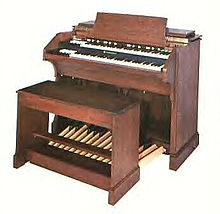Hammond organ
| Hammond organ | |
|---|---|

A Hammond C-3 organ
|
|
| Manufacturer | The Hammond Organ Company (1935–1985) Hammond Organ Australia (1986–1989) Hammond-Suzuki (1989–present) |
| Dates | 1935–1975 (tonewheel models) 1967–1985 (transistor models) 1986–present (digital models) |
| Price | $1,193 (Model A, 1935) $2,745 (Model B-3, 1954) |
| Technical specifications | |
| Polyphony | Full |
| Oscillator | Tonewheel |
| Synthesis type | Additive |
| Effects | Vibrato, reverb, harmonic percussion |
| Input/output | |
| Keyboard | 2 × 61-note manuals, 25-note pedals (consoles) 2 × 44-note manuals, 13-note pedals (spinets) |
| External control | Amphenol connector to Hammond Tone Cabinet or Leslie Speaker |
The Hammond organ is an electric organ, invented by Laurens Hammond and John M. Hanert and first manufactured in 1935. Various models have been produced, most of which use sliding drawbars to create a variety of sounds. Until 1975, Hammond organs generated sound by creating an electric current from rotating a metal tonewheel near an electromagnetic pickup, and then strengthening the signal with an amplifier so that it can drive a speaker cabinet. Around two million Hammond organs have been manufactured. The organ is commonly used with, and associated with, the Leslie speaker.
The organ was originally marketed and sold by the Hammond Organ Company to churches as a lower-cost alternative to the wind-driven pipe organ, or instead of a piano. It quickly became popular with professional jazz musicians in organ trios, a small group centred on the Hammond organ. Organ trios were hired by jazz club owners, who found that organ trios were a much cheaper alternative to hiring a big band. Jimmy Smith's use of the Hammond B-3, with its additional harmonic percussion feature, inspired a generation of organ players, and its use became more widespread in the 1960s and 1970s in rhythm and blues, rock and reggae, as well as being an important instrument in progressive rock.
The Hammond Organ Company struggled financially during the 1970s as they abandoned tonewheel organs and switched to manufacturing instruments using integrated circuits. These instruments were not as popular with musicians as the tonewheels had been, and the company went out of business in 1985. The Hammond name was purchased by the Suzuki Musical Instrument Corporation, which proceeded to manufacture digital simulations of the most popular tonewheel organs. This culminated in the production of the "New B-3" in 2002, which provided an accurate recreation of the original B-3 organ using modern digital technology.
...
Wikipedia
